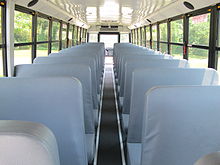Thomas Saf-T-Liner C2
| Thomas Saf-T-Liner C2 | |
|---|---|

Front 3/4 view
|
|

Interior view, looking back
|
|
| Overview | |
| Manufacturer | Thomas Built Buses |
| Production | 2004-present |
| Assembly | High Point, North Carolina |
| Body and chassis | |
| Chassis | Freightliner C2 |
| Related | Freightliner M2 106 |
| Powertrain | |
| Engine |
|
| Capacity | 14-81 |
| Dimensions | |
| Width | 96 in (2,438 mm) |
| Curb weight | 18,000–35,000 lb (8,165–15,876 kg) (GVWR) |
| Chronology | |
| Predecessor |
|
The Thomas Saf-T-Liner C2 (often shortened to C2) is a Type C (conventional-style) school bus produced by Thomas Built Buses. In production since 2004, the C2 is based on a Freightliner C2 chassis, itself derived from the Freightliner Business Class M2 medium-duty conventional. It was introduced as the replacement for the Thomas Conventional and Thomas Saf-T-Liner FS-65; the latter was produced alongside the C2 until December 2006. Due to elements of its design, the C2 can also be considered the successor to the Vista line of Type C buses from the 1990s. The C2 is unique in that it is available in capacities up to 81 passengers, the largest of any type C conventional school bus in current production.
The Saf-T-Liner C2 is built at a $40 million manufacturing facility in High Point, North Carolina.
Following the introduction of the Freightliner Business Class M2 medium-duty truck in 2002 as the replacement for the FL-Series, Freightliner began work on an all-new bus chassis based on the M2 to replace the FS-65 bus chassis. As the parent company of Thomas Built Buses, Freightliner sought to pair the new bus chassis together with a new Thomas body, allowing the bus company to update its Saf-T-Liner Conventional bus body for the first time since 1962.
In 2004, the Saf-T-Liner C2 entered production. The Saf-T-Liner FS-65 that it replaced remained in production until the end of 2006, outliving the Freightliner FL-Series it was derived from.
In October 2012, Thomas delivered its 50,000th Saf-T-Liner C2 to Dean Transportation of Lansing, Michigan.
As the first new Thomas full-size bus body since 1962, manufacturing techniques for the C2 were redesigned. To minimize the number of rivets and welds on the bus body, adhesive bonding was used for many body joints. In the cases where fasteners are needed, self-piercing rivets are used; ideally these do not punch completely through the bottom layer of the metals being joined together, thus reducing the likelihood that rivets will become the source of leaks in the future.
To simplify vehicle maintenance, Thomas introduced multiplexed wiring, replacing individually wired circuits. In the system used in the C2, it also has the advantage that switches on the control panel next to the driver can be rearranged to suit the driver and continue to function without any rewiring or reprogramming.
...
Wikipedia
